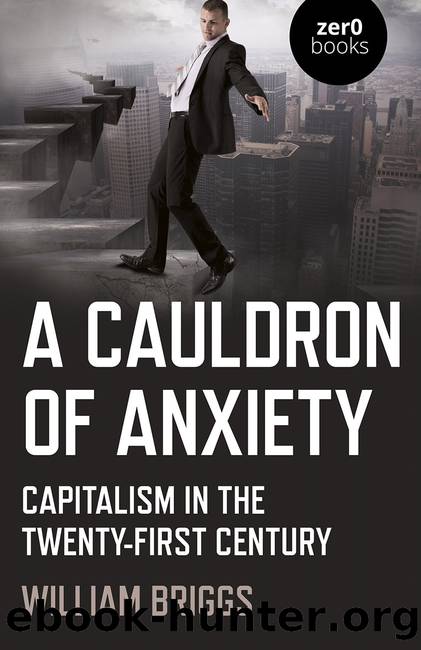A Cauldron of Anxiety: Capitalism in the Twenty-First Century by William Briggs

Author:William Briggs [Briggs, William]
Language: eng
Format: epub
ISBN: 9781789046090
Google: eB-YzQEACAAJ
Publisher: Zero Books
Published: 2021-11-15T23:27:55.162359+00:00
The state learns to embrace populism
Populism ought to be a worrying thing for the state. Its theorists and, importantly, its supporters rail against the âeliteâ. The state apparatus, one would have to accept, is the embodiment of the political elite. It is the state, after all, that calls the shots. Populism, in any telling of the theory, demands a âbottom-upâ approach to politics. The state and populism, one might imagine, are sworn enemies. Something rather odd seems to have happened along the way. Populism has begun to be legitimised. While this might be odd, it is not entirely unusual.
Capitalism and the state have a long and somewhat distinguished career in co-opting ideas and organisations to serve their version of the âgreater goodâ. The organisations of the working class are a prime example. It was briefly discussed earlier how the union movement became legitimised and integrated into the state through a three-phase process of first, hostility, then tolerance and finally cooperation and partnership. A consequence of this integration, as far as the working class is concerned, has been a loss of independence. This is by no means a recent development in state and class relations. âCapitalism is less and less willing to reconcile itself to the independence of trade unions. It demands of the reformist bureaucracy...that they become transformed into its political police before the eyes of the working classâ (Trotsky 1972: 11). Trotsky wrote those words in 1926. How is it not possible to see similarities in how populism is being regarded?
A âbottom-upâ movement can, of course, be a little troubling if you want to maintain control of things. Slowly, the language begins to change. We begin to see the promotion of the idea that populism might have an âup-sideâ. Damon Acemoglu and James Robinson, writing in the influential American Foreign Policy magazine (2019), describe two potential states â the despotic and the impaired â and that between these two runs a narrow corridor. It is in this corridor, they assert, that liberty can rise. Speaking specifically about the American experience, they argue that despite all of the negatives associated with populism, its xenophobia and its nationalism, this very bottom-up mobilisation has the capacity to pull the US back from the edge. What we appear to be witnessing is the legitimisation of populism, the accommodation of the state to populist rhetoric and the integration of the disempowered into the apparatuses of state that first disempowered them. Itâs a neat bit of conjuring.
This idea is given credence by recent research from the Tony Blair Institute for Global Change. As at March 2019, 68 per cent of G20 GDP was controlled by governments that could be described as populist. The same research shows that in 2018 there were 20 elected state leaders who were described as populist (Kyle and Gultchin 2019). What the research is less clear about is that there are more and more instances of mainstream parties adopting elements of populist ideas. The case of Australia, for instance, shows both governing and opposition parties taking on board policies that are clearly populist in nature.
Download
This site does not store any files on its server. We only index and link to content provided by other sites. Please contact the content providers to delete copyright contents if any and email us, we'll remove relevant links or contents immediately.
Zero to IPO: Over $1 Trillion of Actionable Advice from the World's Most Successful Entrepreneurs by Frederic Kerrest(4307)
Machine Learning at Scale with H2O by Gregory Keys | David Whiting(4197)
Never by Ken Follett(3799)
Harry Potter and the Goblet Of Fire by J.K. Rowling(3776)
Ogilvy on Advertising by David Ogilvy(3517)
Shadow of Night by Deborah Harkness(3308)
The Man Who Died Twice by Richard Osman(2998)
Book of Life by Deborah Harkness(2869)
The Tipping Point by Malcolm Gladwell(2829)
Will by Will Smith(2795)
0041152001443424520 .pdf by Unknown(2785)
My Brilliant Friend by Elena Ferrante(2776)
How Proust Can Change Your Life by Alain De Botton(2746)
Purple Hibiscus by Chimamanda Ngozi Adichie(2654)
How to Pay Zero Taxes, 2018 by Jeff A. Schnepper(2603)
Hooked: A Dark, Contemporary Romance (Never After Series) by Emily McIntire(2502)
Rationality by Steven Pinker(2291)
Borders by unknow(2232)
Can't Hurt Me: Master Your Mind and Defy the Odds - Clean Edition by David Goggins(2230)
